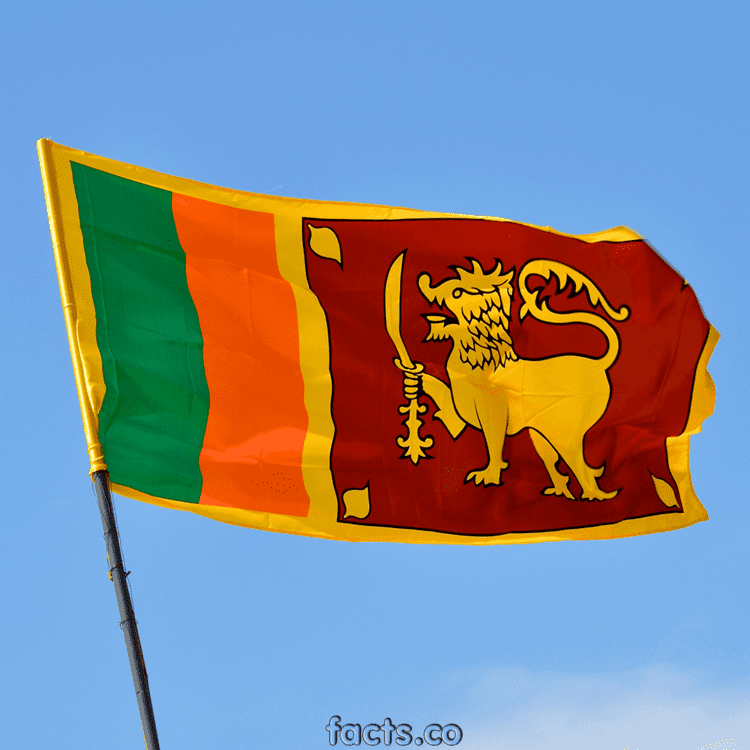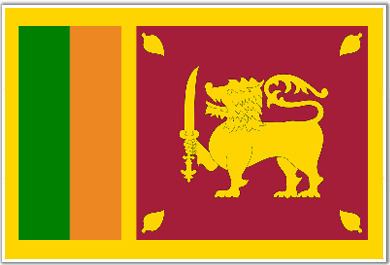Adopted on 22 May 1972 | Proportion 1:2 | |
 | ||
Design Dark red rectangular panel bordered yellow containing a yellow lion holding a sword upright in its right fore paw, and four bo leaves, one in each corner, and next to the hoist two vertical stripes, green and orange, also bordered yellow together. Design A red field with the flag of Sri Lanka in the canton. Design A blue field with the flag of Sri Lanka in the canton. Design A defaced flag of Sri Lanka with Coat of arms of Sri Lanka Design A white field with the flag of Sri Lanka in the canton. Use State flag, Civil ensign, Civil flag | ||
The flag of Sri Lanka (Sinhala: ශ්රී ලංකාවේ ජාතික කොඩිය Sri Lankavay Jathika Kodiya)(Tamil: இலங்கையின் தேசியக்கொடி Ilankaiyin teciyakkoṭi), also called the Lion flag or Sinha flag, consists of a yellow lion holding a kastane sword in its right fore paw in a dark red background with four yellow bo leaves in each corner of the background. Around the background is a yellow border and to its left are two vertical stripes of equal size in green and saffron, with the saffron stripe closest to the lion. The lion represents bravery of Sri Lankans. The four Bo leaves represent four main concepts of Buddhism Mettā, Karuna, Mudita and Upekkha. The stripes represent the two main minority groups. The saffron stripe represents Tamils and the green stripe represents Muslims, and the maroon background represents the majority Sinhalese. The yellow border around the flag represents the unity of Sri Lankans.
Contents

It was adopted in 1950 following the recommendations of a committee appointed by the 1st Prime Minister of Ceylon, The Rt Hon D.S. Senanayake.

History

When Vijaya, the first King of Sri Lanka, arrived in Sri Lanka from India in 486 BC, he brought with him a flag with a symbol of a lion on it. Since then the Lion symbol played a significant role in the history of Sri Lanka. It was used extensively by North Indian prince who followed King Vijaya and it became a symbol of freedom and hope. In 162 BC, when King Dutugemunu embarked on the campaign in which he defeated the South Indian invader Elara, who had ruled the northern part of the island, he carried with him a banner which portrayed a lion carrying a sword on his right forepaw along with two other symbols, the Sun and the Moon.

The banner was in use until 1815, when the reign of the last King of the Kandyan Kingdom, King Sri Vikrama Rajasinha, was brought to an end with the Kandyan nobility's signing of the Kandy convention on 2 March proclaiming King George III as King of Ceylon and replacing the Lion flag with the Union Flag as the national flag of Ceylon. The government of British Ceylon used its own flag. The Lion Flag was taken to England and kept at the Royal Hospital Chelsea.

As the independence movement in Sri Lanka gained strength in the early 20th century, E. W. Perera, a prominent figure of the independence movement with the help of D. R. Wijewardene, the press baron, discovered the original Lion flag in Chelsea. A picture of it was subsequently published in a special edition of the Dinamina newspaper to mark 100 years since the end of Sri Lankan independence. The Lion flag then became a centrepiece of attraction to the public, who for the first time since the fall of the Kandyan Kingdom were now aware of its actual design.
In 1948 the flag was adapted as the national flag of the Dominion of Ceylon, however the flag underwent several changes in 1953 and again in 1972. During the same year four leaves of the Bo tree were added to the four corners of the Sri Lankan National flag under the direction of Nissanka Wijeyeratne. At the time, he was Permanent Secretary to the Ministry of Cultural Affairs and Chairman of the National Emblem and Flag Design Committee. Prior to 1972, the corners of the flag were occupied by symbols depicting spearheads. The four Bo Leaves added by Wijeyeratne reflect the core principles of Mettha (loving kindness), Karuna (compassion), Upeksha (equanimity) & Muditha (happiness).
Symbolism
The national flag of Sri Lanka represents the country and its heritage as rallying device that integrates the minorities with the majority race. Most symbols in the flag have been given distinctive meanings.
